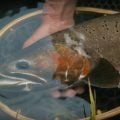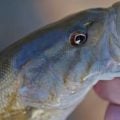How to Tie a Winter Wonder
Producer: Tim Flagler
I call this tasty little steelhead snack the Winter Wonder. It’s a way simplified version of a steelhead nymph I’ve been tying and fishing for years. In this form, it’s easier to tie, sinks much faster and tends to be more durable, yet is no less effective. Sometimes, simpler is better.
The Winter Wonder starts with a Fulling Mill 51 15 size 10 hook. To make handling easier, I’ll get hold of the hook with plunger-style hackle pliers. Doing this allows me to easily stab the small hole of a black nickel 1/8” tungsten bead, then get the whole assembly firmly secured in the jaws of my tying vise.
.02 round lead free wire is used to add weight and to help stabilize the bead. While holding the wire spool in your right hand, get hold of the bitter end with your left. Start taking wraps with the wire around the hook shank, 5 or 6 turns is usually enough. With the turns complete, helicopter the wire to break it off close.
A small drop of super glue, here Fly Tyer’s Z-ment applied to the hook shank between the wraps and the bead, will hold everything in place once the wraps have been slid forward and the adhesive has set. This also makes it easy to tuck in the wire tail without everything spinning.
UTC 140 Denier thread in peacock blue is used to create the body of the fly. Get your thread started on the hook shank behind the wire and, after taking a few wraps rearward, snip off the excess tag. Then, wind your thread forward over the wire wraps to further secure them. End with your thread at about the hook point.
Medium-sized black Ultra wire is used to rib and segment the fly, a 6” length will make numerous Winter Wonders. Butt one end of the wire against the wire wraps and begin securing it to the hook shank with wraps of tying thread. Go well down into the hook bend then return your thread forward to the back edge of the bead.
To add some taper, first go 1/3 of the way down the hook shank with your tying thread then go back to the bead. Then go 2/3 of the way down and back. Finally go all the way down and stop at the end of the body. Give your bobbin a good counterclockwise spin to uncord and flatten the thread then take wraps forward to smooth the body out. End with your tying thread at the back edge of the bead.
Get hold of the wire and start making open spiral wraps with it, up the hook shank, over top of the thread body. At the back edge of the bead, secure the wire with wraps of tying thread then helicopter to break it off close.
Blue Steelie Ice Dub is used for the thorax of the fly, a small wisp is all you need. Pull down on your bobbin to expose about 3” of tying thread then use the dubbing to create an extremely slender 3” long noodle on the thread. Start taking wraps with the noodle to build up a short little thorax on the fly. Take a few more bare thread wraps to create a small collar.
Reach for your whip finish tool and use it to do a 5 or 6 turn whip finish, seat the knot well and snip or cut your tying thread free. A drop of head cement, or here Sally Hansen Hard as Nails, applied to the thread wraps will ensure they don’t come unraveled and increase the fly’s durability.
One of the cool things about this pattern is that it can be easily downsized to say a 16, with a 3/32” bead, 70 Denier thread and brassie-sized Ultra wire. The end result is a super cool trout-sized Winter Wonder.
Although it isn’t always the case, sometimes removing materials from a fly pattern will not only make it easier to tie but actually make it more effective.
How to Tie a Whistle Pig Jig
How to Tie a Wood Duck Heron











